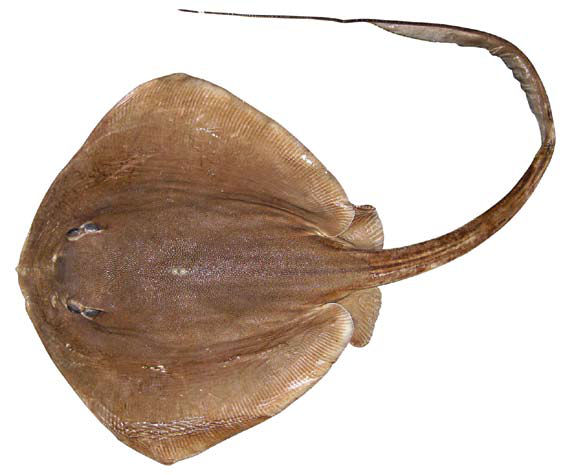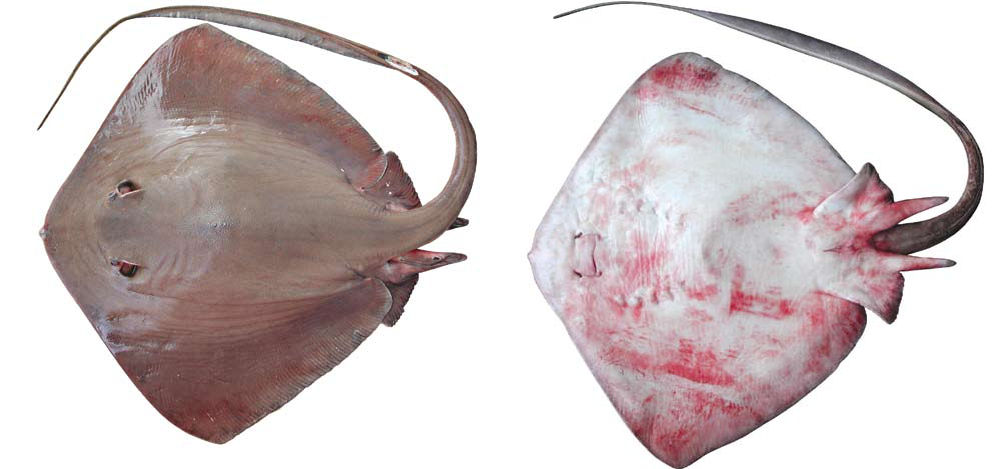Pastinachus gracilicaudus
Last & Manjaji-Matsumoto, 2010
Narrowtail stingray
Classification: Elasmobranchii Myliobatiformes Dasyatidae
Reference of the original description
Description of a new stingray, Pastinachus gracilicaudus sp. nov. (Elasmobranchii: Myliobatiformes), based on material from the Indo-Malay Archipelago. CSIRO Marine and Atmospheric Research Paper, 32, 115–128
Description of a new stingray, Pastinachus gracilicaudus sp. nov. (Elasmobranchii: Myliobatiformes), based on material from the Indo-Malay Archipelago. CSIRO Marine and Atmospheric Research Paper, 32, 115–128
Image of the original description

Pastinachus gracilicaudus sp. nov, juvenile male holotype (SMEC 35, 364 mm DW, preserved): dorsal surface. In: Last, P.R. & Manjaji-Matsumoto, B.M. (2010): Description of a new stinGray, Pastinachus gracilicaudus sp. nov. (Elasmobranchii: Myliobatiformes), based on material from the Indo-Malay Archipelago. CSIRO Marine and Atmospheric Research Paper, 32: 115-128

Pastinachus gracilicaudus sp. nov, juvenile male holotype (SMEC 35, 364 mm DW, preserved): dorsal surface. In: Last, P.R. & Manjaji-Matsumoto, B.M. (2010): Description of a new stinGray, Pastinachus gracilicaudus sp. nov. (Elasmobranchii: Myliobatiformes), based on material from the Indo-Malay Archipelago. CSIRO Marine and Atmospheric Research Paper, 32: 115-128
Synonyms / new combinations and misspellings
Pastinachus cf. gracilicaudus
Pastinachus cf. gracilicaudus
Types
Pastinachus gracilicaudus
Holotype: SMEC: 35 (previous field no. BKK 35); Paratype: BMNH: 1867.11.28.168; BMNH: 1926.12.21.1; CSIRO: H 7109-02 ; CSIRO: H 7109-01 ; CSIRO: H 7108-01; CSIRO: H 5864-04 ; CSIRO: H 7107-01; CSIRO: H 5615-03 ; CSIRO: H 5864-03; CSIRO: H 5612-02; CSIRO: H 4213-02 ; CSIRO: H 5480-03; CSIRO: H 4426-28; IPMB: 38.09.12; IPMB: 38.09.10; IPMB: 38.01.11 ; IPMB: 38.01.09; IPMB: 38.01.10; IPMB: 38.09.09; MZB: 18227 (KA 162A); SFRI: 27404-2; SFRI: 28404-15; ZRC: 50645;
Pastinachus gracilicaudus
Holotype: SMEC: 35 (previous field no. BKK 35); Paratype: BMNH: 1867.11.28.168; BMNH: 1926.12.21.1; CSIRO: H 7109-02 ; CSIRO: H 7109-01 ; CSIRO: H 7108-01; CSIRO: H 5864-04 ; CSIRO: H 7107-01; CSIRO: H 5615-03 ; CSIRO: H 5864-03; CSIRO: H 5612-02; CSIRO: H 4213-02 ; CSIRO: H 5480-03; CSIRO: H 4426-28; IPMB: 38.09.12; IPMB: 38.09.10; IPMB: 38.01.11 ; IPMB: 38.01.09; IPMB: 38.01.10; IPMB: 38.09.09; MZB: 18227 (KA 162A); SFRI: 27404-2; SFRI: 28404-15; ZRC: 50645;
Description :
Citation: Pastinachus gracilicaudus Last & Manjaji-Matsumoto, 2010: In: Database of modern sharks, rays and chimaeras, www.shark-references.com, World Wide Web electronic publication, Version 05/2025
Please send your images of "Pastinachus gracilicaudus" to info@shark-references.com

Pastinachus gracilicaudus sp. nov, adult male paratype (SFRI 28404–15, 747 mm DW, fresh): dorsal surface/ventral surface. In: Last, P.R. & Manjaji-Matsumoto, B.M. (2010): Description of a new stinGray, Pastinachus gracilicaudus sp. nov. (Elasmobranchii: Myliobatiformes), based on material from the Indo-Malay Archipelago. CSIRO Marine and Atmospheric Research Paper, 32: 115-128

Pastinachus gracilicaudus sp. nov, adult male paratype (SFRI 28404–15, 747 mm DW, fresh): dorsal surface/ventral surface. In: Last, P.R. & Manjaji-Matsumoto, B.M. (2010): Description of a new stinGray, Pastinachus gracilicaudus sp. nov. (Elasmobranchii: Myliobatiformes), based on material from the Indo-Malay Archipelago. CSIRO Marine and Atmospheric Research Paper, 32: 115-128
Short Description
This medium-sized species (attaining about 75 cm DW) is distinguished by the following set of characters: snout rounded, not produced, angle more than 115°, apex largely naked and lacking enlarged denticles; disc length 83-89% DW; head length 38-41% DW; preoral length 15-17% DW; distance between nostrils 7-8% DW; distance between first gill slits 18-20% DW; tail compressed above mid-base of ventral cutaneous fold, its width 0.5-0.8 times its height; ventral fold low and slender, length 0.7-1.0 times DW, 17-22 times its depth below its mid-base, depth 2.0-3.6 times tail height at its mid-base; distance from anterior cloaca to sting 0.8-1 in precloacal length; two large, midscapular pearl thorns, usually preceded by a smaller irregular thorn; 120-122 pectoral-fin radials; monospondylous vertebral centra (exc. synarcual) 37-40 (Ref. 84288).
This medium-sized species (attaining about 75 cm DW) is distinguished by the following set of characters: snout rounded, not produced, angle more than 115°, apex largely naked and lacking enlarged denticles; disc length 83-89% DW; head length 38-41% DW; preoral length 15-17% DW; distance between nostrils 7-8% DW; distance between first gill slits 18-20% DW; tail compressed above mid-base of ventral cutaneous fold, its width 0.5-0.8 times its height; ventral fold low and slender, length 0.7-1.0 times DW, 17-22 times its depth below its mid-base, depth 2.0-3.6 times tail height at its mid-base; distance from anterior cloaca to sting 0.8-1 in precloacal length; two large, midscapular pearl thorns, usually preceded by a smaller irregular thorn; 120-122 pectoral-fin radials; monospondylous vertebral centra (exc. synarcual) 37-40 (Ref. 84288).
Distribution
Western Pacific: This species is reasonably common but patchily distributed in both Malaysian and Indonesian Borneo, including Sabah, Sarawak, and western and northeastern Kalimantan. Possibly more widespread in the Indo-Malay Archipelago, east to at least the Wallace Line and the the identity of a specimen collected off Beruwala (Sri Lanka) needs confirmation.
Western Pacific: This species is reasonably common but patchily distributed in both Malaysian and Indonesian Borneo, including Sabah, Sarawak, and western and northeastern Kalimantan. Possibly more widespread in the Indo-Malay Archipelago, east to at least the Wallace Line and the the identity of a specimen collected off Beruwala (Sri Lanka) needs confirmation.
Biology
The depth occupied by this species is unknown as most material were collected in fish markets, but probably mainly coastal. A 69.5 cm DW adult male weighed ca 12 kg. Size at birth apparently variable; 83.0 cm DW female delivered a full term embryo with small umbilical scar; however, other retained specimens, 26.1 cm DW still had a substantial yolk sac, while in another 19.3 cm DW specimen the umbilical scar was barely visible. All these young specimens have large mid-scapular tubercles and well-developed denticles over most of the dorsal disc; a small embryo with yolk sac (16.5 cm DW) had prominent mid-scapular tubercles, but other denticles are just starting to form on the disc (Ref. 84288). Tropical
The depth occupied by this species is unknown as most material were collected in fish markets, but probably mainly coastal. A 69.5 cm DW adult male weighed ca 12 kg. Size at birth apparently variable; 83.0 cm DW female delivered a full term embryo with small umbilical scar; however, other retained specimens, 26.1 cm DW still had a substantial yolk sac, while in another 19.3 cm DW specimen the umbilical scar was barely visible. All these young specimens have large mid-scapular tubercles and well-developed denticles over most of the dorsal disc; a small embryo with yolk sac (16.5 cm DW) had prominent mid-scapular tubercles, but other denticles are just starting to form on the disc (Ref. 84288). Tropical
Habitat
Benthopelagic; marine
Benthopelagic; marine
Remarks
shark-references Species-ID=9013;
shark-references Species-ID=9013;
Parasites (arranged by Jürgen Pollerspöck)
Cestoda
Cestoda
- Halysioncum vojtai (Kuchta & Caira, 2010) [19536]
- Prochristianella clarkeae Beveridge, 1990 [17404] [21816]
- Rhinoptericola jensenae (Schaeffner & Beveridge, 2012) [17404] [21816]
- Tetrarhynchobothrium unionifactor (Shipley & Hornell, 1904) [21816]
















